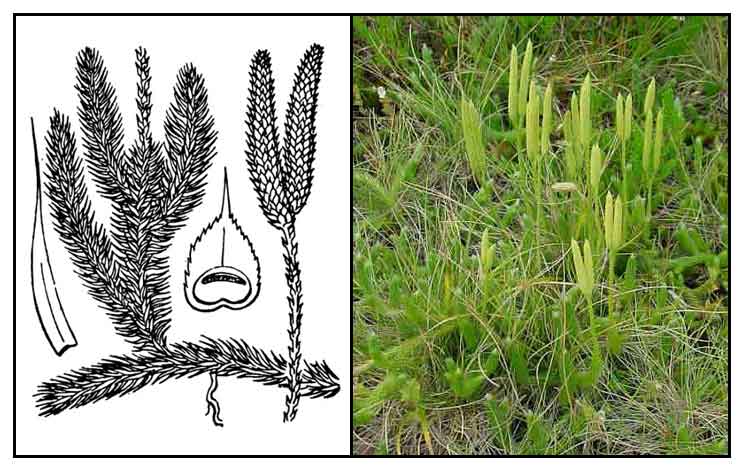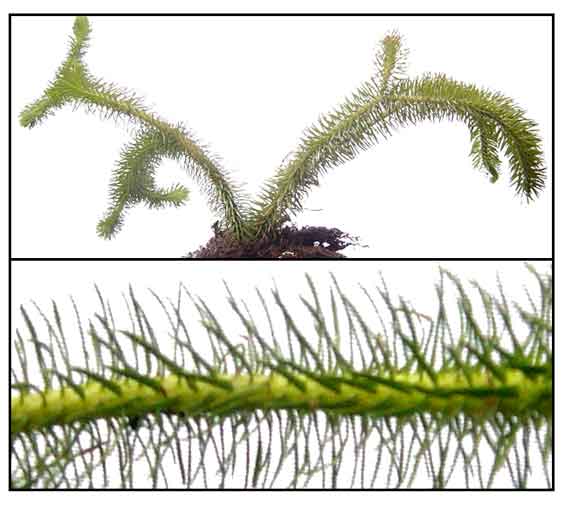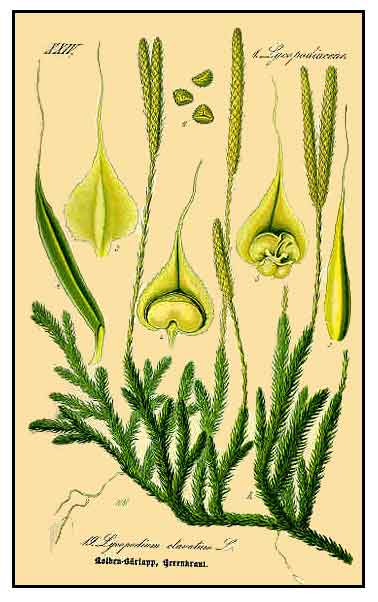|
 Gen info Gen info
- Lycopodium is Greek-derived, lukos (wolf) and podo (foot); called "wolf's foot" from its resemblance of the branch tips to a wolf's paw. clavatum, from Latin, means "club shaped."
- Lycopodium is one of nine genera in the subfamily Lycopodioideae, comprising 9 to 15 species. In other classifications, the genus is equivalent to the whole of the subfamily, including all other genera, and with more than 40 accepted species. (25)
Botany
Licopodio is a perennial with prostrate,
creeping, tough and flexible woody stem, growing to a length up to 5
meters or more, dichotomously branched, with short and ascending branches. Leaves
are very numerous, small and persistent, 5 to 8 millimeters long, closely placed
and densely imbricated on the stem, points all turned somewhat upwards, sessile, linear-oblong, the apex
terminating in a hairlike process as long as the leaf. Spikes are borne
singly or in pairs, at the end of the erect and slender stiff branches,
2.5 to 6 centimeters long, cylindric, linear, blunt and composed of short-stalked
imbricated bracts, terminating to a long filiform point. Spores are
pale yellow, very minute, tetrahedral, and finely reticulated.
 Distribution Distribution
- In the Philippines, limited to the high mountainous
areas of Luzon.
- Extensively distributed globally, found in the temperate and colder regions of both hemispheres and in the Old and New Worlds.
Constituents
- Principal constituent
is a fixed oil, 47 %, described as a bland and maintaining liquidity even at low temperatures of 5º Fahrenheit.
- Study yielded three serratene triterpenoids.
- Study yielded alkaloids lycopodine (major alkaloid), clavatine and clavatoxine; polyphenolic acids including dihydrocaffeic; flavonoids including apigenin, and triterpenes.
- Study has yielded active principles viz., clavatin, annotin, lycopodine, nicotine triterpene, flavonoids, and minerals. GC-MS analysis of ethanolic extract
yielded lycopodine (58.26%) as one of the most abundant alkaloids. (see study below) (21)
Properties
Considered analgesic, anti-inflammatory, antirheumatic, antioxidant, antipruritic, antispasmodic,
carminative, decongestant, demulcent, diuretic, emmenagogue, tonic.
Parts utilized
Entire plant.
 Uses Uses
Folkloric
- Polvo de licopodio is
used as a dusting powder for excoriated skin problems, as in the intertrigo of infants, and in eczema and erysipelas.
- Used for gout and rheumatism.
- Used to stimulate the appetite.
- Used to relieve spasmodic retention of urine in children.
- Used for urinary and kidney stones.
- Used for constipation, piles, flatulence, enteritis, bronchitis and pneumonia.
- In the Visayas, the material is crushed
or finely chopped, heated with salt, for application to insect and centipede
bites.
- In China, decoction of the plant used for
beriberi and nervous conditions.
- In India, used for the treatment of inflammation-related
diseases.
- In the Pyrenees region, plant is used as a diuretic.
- Used for healing of bed sores – finely powdered club moss is spread over the open sores.
- infusion used for liver cirrhosis and malignant liver conditions.
- Spores inhaled to stop bleeding noses; applied to wounds and various skin diseases.
- The Obo community of South Cotobato use plant preparations for body pains and as anti-aging facial wipes. (18)
Others
- Pharmacy: Used to envelop
pills to prevent in from sticking; also to alter the taste.
- Mordant: Used as mordant in dyeing.
- Weaving: Stems made into matting.
- Lighting: Used as flash powder in early photography and magic acts. Used in fireworks and artificial lighting.
- Homeopathy: Lycopodium is one of the most commonly used plant in homeopathy. Used for premature ejaculation and erectile dysfunction. (see below for homeopathic studies)
Preparations
• Infusion: An infusion is made with 1/4 liter of boiling water poured over a level teaspoon of Club Moss. 1 cup is taken in small sips, half an hour before breakfast. For malignant diseases of the liver and cirrhosis, 2 cups daily.
• Club Moss Pillow: 100 to 300 gm depending on the size of the area affected by cramp. Stuff the material into a pillow and apply to the aching area overnight. (Pillow retains can be used for a year.)
Toxicity & Allergy concerns
• Constituents: Contains lycopodine which may be paralyzing to the motor nerves. Contains clavatine which is toxic to many mammals. Spores are not known to be toxic.
• Asthma: Report of occupational asthma in two women employed in the manufacture of condoms. The spores of LC, used as a rubber dusting agent, were identified as the causative agent. (9)
Studies
• Anti-Inflammatory: Study of extracts showed anti-inflammatory activity probably from the
alkaloid compounds and supports its folkloric use. (1)
• Antimicrobial / Antifungal / Antiviral: All extracts showed activity against test strains of S aureus. LC extracts showed antifungal activity. Only the chloroform extract showed activity against HSV. All extracts showed insignificant antiradical effect on DPPH. Lycopodine was identified as the major alkaloid. (2)
• Hepatoprotective / Antitumor: Study evaluated the protective effect of a plant extract in mice chronically fed hepato-carcinogens. Treatment
with spore extract of Lycopodium clavatum had a significant reduction
of tumor incidence in the liver of carcinogen intoxicated mice. Results
validate the extract use in complementary and alternative use against
hepatotoxicity. (4)
• Lycopodine / Anti-Cancer Property / Chemotherapeutic Potential: Crude ethanolic extract of LC is a mixture of about 200 alkaloids. Results showed that lycopodine considerably inhibited growth of HeLa cells indicating its potential use in chemotherapy. (8)
• Hepatoprotective / CCl4-Induced Damage: Study evaluated the hepatoprotective action of L. clavatum against carbon tetrachloride-induced damage in rats. Results showed control of biochemical parameters. The protective action was confirmed by microanatomical studies of hepatic tissues. (10)
• Chemical Marker Powder / Forensic Use: Study showed a powder, based on L. clavatum spores, to have potential for use as a chemical marker for forensic evidence of persons having handled objects. The rate of loss in the decay curve (decrease in spores) was highest in the first two hours. (11)
• Analgesic and CNS Depressant Effects / Forensic Use: Study investigated the possible analgesic and behavioral effects of homeophathic formulations of L. clavatum in animal models using hot plate, ice place, Randall-Selitto tests and behavioral effects using rota rod and open field tests. Results showed homeopathic formulations possess central nervous system depressant activity. (12)
• Antiprotozoal Activity: Study investigated the antiprotozoal activity of extracts of L. clavatum and L. camplanatum L. subsp. chamaecyparissus against Trypanosoma brucei rhodesiense, T. cruzi, Leishmania donovani and Plasmodium falcifarum. Results showed both fern species contain antiprotozoal activity with no cytotoxicity. (13)
• Antioxidant: Study evaluated the efficacy of club moss (L. clavatum) and blessed thistle (Cnicus benedictus) hydroalcoholic extracts in preventing oxidative stress damage in liver tissue of mice. Results showed treatment of mice with plant phenophenols resulted in marked improvement in most of the studied parameters. (14)
• Anti-Cancer / Homeopathically Potentized Dilutions: Study of homeopathically potentized ultrahigh dilutions of L. clavatum (LC-5C and LC-15C) demonstrated an ability to induce apoptosis in cancer cells. (15)
• Effect on Memory and Cerebral Blood Flow: Study has shown acetyl cholinesterasee (AchE) inhibitory effect in Lyc alkaloid extract. Study evaluated the effect of Lyc on learning and memory function and cerebral blood flow (CBF) in intracerebrovascularly STZ induced memory impairment in rats. Results showed improvement in learning and memory and increased in CBF in rats at all potencies of Lyc studied. (17)
• Antioxidant: Study evaluated the secondary metabolites and antioxidant property of decoction and ethanolic extracts of L. clavatum. Results showed antioxidant activity on DPPH assay which may be attributed to the presence of flavonoids, steroids, and flavanoids. (18)
• Effect of Potentized Homeophathic Lycopodium clavatum in the Treatment of Polycystic Ovarian Syndrome (PCOS): Study reports of the relative efficacy of two potentized homeopathic remedies—Calcarea carbonica and Lycopodium clavatum—for the removal of ovarian cysts in a study of 40 patients. Results showed both plants showed removal of cysts in 21 patients, with amelioration of relevant symptoms and no reported side effects. (19)
• Effect on Aging-Induced Testicular Function: Study evaluated the effects of ethanolic extract of Lygodium clavatum on aging induced alteration in testicular function. Depleted testosterone level improved in all treated rats with improvement in sperm parameters. Effects seemed to be dose-dependent. (20)
• Bacteriostatic / Hepatoprotective: Study evaluated the hepatoprotective and antimicrobial effects of Lycopodium clavatum and Equisetum arvense against xenobiotic intoxication or microbial infection. Liver injury was induced by acetaminophen in a mice model. Results showed the hydroalcoholic extract had only moderate hepatoprotective and antimicrobial effects. The extracts induced a moderate bacteriostatic effect on growth of most of the tested bacteria, but no against fungi. The principle hepatoprotective compound was lycopodine. (see constituents above) (21)
• Antiurolithiatic / Clinical Trial: A multicentric, randomized, double-blind, placebo controlled trial evaluated the efficacy of Lycopodium clavatum in the management of urolithiasis. Patients were prescribed the homeopathic medicines or conventional medicines. Study showed there was not statistical significance between the groups (p=0.31) in reference to number of cases where stones were expelled during the trial. A statistical difference was found between between groups (p=0.039) for pain and positive trend for homeopathy was noted for dysuria. Further studies with pragmatic study design and individualistic Homeopathy can be undertaken to assess the effectiveness of treatment in urolithiasis. (22) No efficacy was found for L. clavatum for urolithiasis in a double-blind, randomized trial However, there was a positive trend seen for pain relief. (23)
Availability
- Wildcrafted.
- Cultivated.
- Pellets, powders, extracts in the cybermarket.
|



 Distribution
Distribution  Uses
Uses

